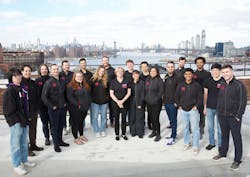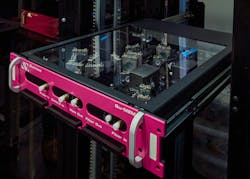Qunnect is on a mission to build the quantum internet
Quantum networking is often described in future tense—but it’s happening today at NY-based startup Qunnect. The science and commercialization of replacing classical physics with quantum physics as the basis for connecting devices and computers across long distances is taking off and poised to change the world of communications and data sharing.
Companies ranging from telecom and financial services to defense and tech industries are finding new uses for quantum networking. For Qunnect, that is driving our excitement as deployment of new quantum technologies and testbeds plays a key role.
Quantum networking’s ability to enable new forms of secure connectivity, such as provably secure communication and entangled sensor networks, has benefits for industry that have yet to be tapped into, well beyond enabling scalable quantum computing.
At its core, quantum networking relies on quantum physics and a phenomenon called quantum entanglement to enable connections between photons that can’t be cloned or intercepted—in a way classical networks can’t compete with.
Enter Qunnect, which introduced a complete suite of quantum networking technologies in 2024. Within months, companies like Deutsch Telekom and Cisco were testing our quantum technologies on their own fiber networks.
The difficulty for us, and for many deep-tech startups, was that the tools necessary for this work did not exist. We took the hard path of creating a post of new technologies because there were no commercially available components we could pull off the shelves for our work. Instead, we had to reimagine the network and then invent and create it all from scratch. Our systems are now installed within commercial metro fiber networks running under several major global cities.
From research to rack
We began our entrepreneurial journey as graduate students intent on commercializing a quantum memory, a component widely recognized as the key to extend the reach of quantum networks—and founded Qunnect to support this goal.
We soon met our third founder, Noel Goddard, who joined Qunnect as our CEO in 2020. She has a dual background in science and entrepreneurship, and together we saw the potential of building the foundational components of a quantum network that would become our quantum networking product suite.
Since then, Qunnect has launched six first-of-a-kind products and a full rack system, and achieved our early dreams of a turnkey solution for entanglement-based networking over commercial-grade telecom fiber.
Networks based on quantum entanglement are orders of magnitude more sensitive to environmental disturbances and time correlations between each node compared to their classical counterparts. To manage that, we built a platform to combine entanglement sources, active polarization stabilization, and subnanosecond node synchronization—all packaged for 24/7 field operation.
We know this infrastructure must work on day one, which requires getting the technology into the hands of customers and testing it within real-world conditions.
Putting entanglement to work
Our flagship deployment is the GothamQ network, a testbed that sends quantum entangled photons through telecommunications fiber beneath New York City—a challenging environment for quantum optics. As a result, New York City has proven to be the perfect location to demonstrate the company’s systems and their ability to perform stable, high-rate entanglement distribution over miles of city fiber.
GothamQ has caught the attention of other companies. Telecoms within the U.S., Canada, and the European Union are actively integrating Qunnect’s stack into their infrastructure for testing. Some are already preparing to offer quantum-based services to customers within the next few years.
Our GothamQ deployment marked a tectonic shift in the maturation of the quantum networking industry—taking the field from “quantum as research” to “quantum as infrastructure.”
We view the use of testbeds as the launching pad for quantum networking aligns with history and the path of the original internet. In the early days of classical networking, everything was experimental. Optical amplifiers, transceivers, switches—none were plug-and-play. But the U.S. Defense Advanced Research Projects Agency (DARPA) and the National Science Foundation (NSF) built testbeds. They iterated, and it’s what made the internet real. We’re doing the same thing, just with the next generation of information currency—entangled photons.
Hardware that leaves the lab
Today, Qunnect offers full-stack racks that house all the required components for initiating entanglement distribution over standard telecom fiber. But our team is pushing forward on next-generation technologies, like quantum repeaters, which are a necessary ingredient for global-scale quantum networking.
There’s still a lot of work to do, but we’ve already crossed the line and know our technology works. Now it’s about how fast we can scale, how fast we can drive cost down, and how many use-cases we can unlock.
Use cases fire the imaginations of companies striving to stay at the forefront of their industry. When a new capability—like quantum networking, or AI before it—comes to market, companies want to understand how that capability will reshape their industry and potentially offer them an advantage.
Testbeds provide a place to test and innovate. Qunnect is already in discussions with partners to pilot quantum-secure communication links, edge sensing arrays, and even hybrid architectures that integrate entanglement into classical networking protocols. Our goal is not to replace the internet but rather to upgrade it with entanglement.
We are as deep-tech as deep-tech can be. But just like other infrastructure technologies, if we do our job right, our customers won’t need to understand quantum physics or entanglement to unlock the exciting future applications of quantum networking.
More on Qunnect
About the Author
Maël Flament
Maël Flament is cofounder and chief technology officer at Qunnect (Brooklyn, NY).
Mehdi Namazi
Mehdi Namazi is cofounder and chief science officer at Qunnect (Brooklyn, NY).



